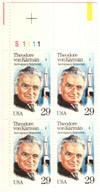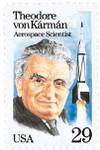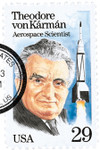
# 2699 - 1992 29c Dr. Theodore von Karman
US #2699
1992 Dr. Theodore von Kármán
- Von Kármán was the first US Medal of Science recipient
- He was called the “Architect of the Space Age”
Stamp Category: Commemorative
Value: 29¢, First Class Mail Rate
First Day of Issue: August 31, 1992
First Day City: Washington, DC
Quantity Issued: 142,500,000
Printed by: Stamp Venturers
Printing Method: Photogravure
Format: Printing cylinders of 200 (20 across, 10 down), split into panes of 50 (10 across, 5 down)
Perforations: 10.9
Why the stamp was issued: Doctor von Kármán was the founder of the Jet Propulsion Laboratory at California Institute of Technology. His work paved the way for aerospace technology that led to the US landing on the moon.
About the stamp design: The stamp’s artwork was created by Christopher Calle, who is the artist behind the 2019 First Men on the Moon, 50th Anniversary stamp. He used a photograph of von Kármán from Aerojet General Corporation, which the scientist helped found. Calle used colored pencils, watercolors, and dies in his portrait.
First Day City: The First Day of Issue ceremony took place on the opening day of the World Space Congress in Washington, DC. The themes of the Congress “Discovery, Exploration, and Cooperation.”
Unusual fact about this stamp: Shirley Thomas, a biographer of von Kármán, led the campaign to honor the scientist with a stamp. She began her campaign in 1965, two years after von Kármán’s death. In 1983, she formed the Committee for the Theodore von Karman Postage Stamp and recruited former astronauts, stamp artists, educators, and scientists to write letters to the postmaster general in support of the stamp. The greatest challenge Thomas faced was that von Karman’s name was not well-known outside the scientific community. All her worked paid off, when the announcement was made in 1991 that Dr. von Karman would be honored on a stamp the following year.
US #2699
1992 Dr. Theodore von Kármán
- Von Kármán was the first US Medal of Science recipient
- He was called the “Architect of the Space Age”
Stamp Category: Commemorative
Value: 29¢, First Class Mail Rate
First Day of Issue: August 31, 1992
First Day City: Washington, DC
Quantity Issued: 142,500,000
Printed by: Stamp Venturers
Printing Method: Photogravure
Format: Printing cylinders of 200 (20 across, 10 down), split into panes of 50 (10 across, 5 down)
Perforations: 10.9
Why the stamp was issued: Doctor von Kármán was the founder of the Jet Propulsion Laboratory at California Institute of Technology. His work paved the way for aerospace technology that led to the US landing on the moon.
About the stamp design: The stamp’s artwork was created by Christopher Calle, who is the artist behind the 2019 First Men on the Moon, 50th Anniversary stamp. He used a photograph of von Kármán from Aerojet General Corporation, which the scientist helped found. Calle used colored pencils, watercolors, and dies in his portrait.
First Day City: The First Day of Issue ceremony took place on the opening day of the World Space Congress in Washington, DC. The themes of the Congress “Discovery, Exploration, and Cooperation.”
Unusual fact about this stamp: Shirley Thomas, a biographer of von Kármán, led the campaign to honor the scientist with a stamp. She began her campaign in 1965, two years after von Kármán’s death. In 1983, she formed the Committee for the Theodore von Karman Postage Stamp and recruited former astronauts, stamp artists, educators, and scientists to write letters to the postmaster general in support of the stamp. The greatest challenge Thomas faced was that von Karman’s name was not well-known outside the scientific community. All her worked paid off, when the announcement was made in 1991 that Dr. von Karman would be honored on a stamp the following year.











